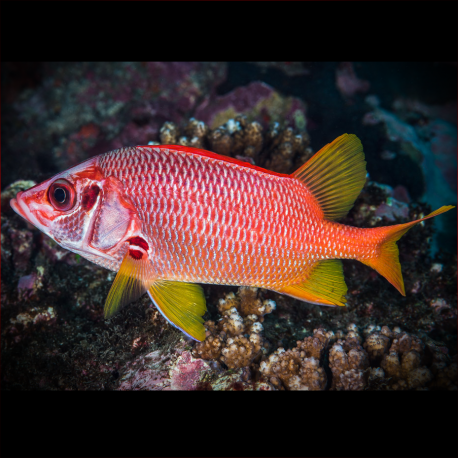More info
Datasheet
| Minimum Tank Size | 1500 litres / 396.26 US gallons |
| Maximum Size | 51.0cm / 20.08inches |
| Reef Compatible | Reef safe with caution |
| Temperament | Might be aggressive |
| Temperature | 22.2°C / 71.96°F - 25.6°C / 78.08°F |
| Specific Gravity | 1.020-1.025 |
| Carbonate Hardness | 8-12 |
| pH | 8.1-8.4 |
General Description
The Sabre squirrelfish, scientifically known as Sargocentron spiniferum, belongs to the Holocentridae family, specifically the Sargocentron genus. This species, commonly referred to as the Sabre squirrelfish, Spinecheek squirrelfish, Spiny squirrelfish, or Long-jawed squirrelfish, is native to the vast Indo-Pacific region, ranging from the Red Sea and East Africa to the Hawaiian Islands, southern Japan, and Australia.
Aquarium Suitability
With a hardiness level described as "Hardy," these squirrelfish are deemed suitable for aquariums but require specific care due to their potentially aggressive nature, especially if not provided with adequate space. They can be threatening towards smaller fish and crustaceans, and caution is advised when handling them as they possess venomous properties, with toxins that can cause pain, although rarely dangerous to humans.
Demands, Care, and Hardiness
The Sabre squirrelfish thrives in aquariums with dim lighting, as they are nocturnal creatures and most active under subdued or darkened conditions. It is recommended to offer living prey initially to help them acclimate to the tank. Their shy nature upon introduction to a new environment may prompt aggressive behavior if suitable hiding spots or territories are lacking.
Reef Suitability
Reef enthusiasts can include the Sabre squirrelfish in their tank with caution as they are considered reef-safe, but may exhibit aggressive tendencies towards other tank inhabitants.
Aquarium Setup
For an optimal habitat, it is suggested to house the Sabre squirrelfish in a tank of at least 1500 liters with ample hiding spots such as caves, overhangs, and coral branches. They prefer environments with stony corals like Acropora coral or other suitable hiding places for security and comfort.
Behaviour
These squirrelfish are generally secretive and prefer to be active during nighttime. They have spikes on their head and gills that can get entangled in fishnets, potentially resulting in wounds or discomfort if mishandled.
Feeding and Diet
Feeding the Sabre squirrelfish should consist of a varied diet including fish, larger crustaceans, other invertebrates, and small crustaceans like krill, mysis, and artemia to ensure proper nutrition and health.
Dimorphism
While information regarding dimorphism is not provided, captive reproduction of the Sabre squirrelfish is not covered either, warranting further observation and research in this area.
Habitat and Distribution
These fish are commonly found in the Indo-Pacific region, from the Red Sea and East Africa to as far as the Hawaiian Islands, southern Japan, and Australia, where they reside in coral reefs, seeking shelter amongst coral branches and in caves for protection.

